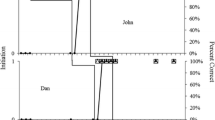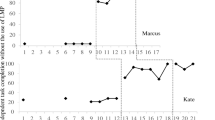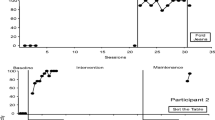Abstract
Three male high school students with autism spectrum disorders participated in this study. Vocational and daily living skills were taught using video prompting via an iPhone. Specifically, using a washing machine, making noodles, and using a copy machine were taught. A multiple probe design across behaviors replicated across participants was used to evaluate the effectiveness of the intervention. Results indicate that the three participants increased performance across all behaviors by increasing the percent of steps performed independently. This study introduces a novel approach to using instructional video, in that two of the three students were able to learn how to self-prompt with the iPhone and ultimately teach themselves the target skills. Maintenance probes were also conducted and the iPhone had to be returned to all three participants for two out of three behaviors for a return to criterion levels. In addition to study limitations, implications for practice for video self-prompting are discussed.



Similar content being viewed by others
References
Alpern, G. (2007). Developmental profile 3 (DP-3). Los Angeles: Western Psychological Services.
Ayres, K. M., & Gast, D. L. (2010). Dependent measures and measurement procedures. In D. L. Gast (Ed.), Single subject research methodology in behavioral sciences (pp. 329–81). New York: Routledge Publishers.
Ayres, K. M., & Langone, J. (2005). Intervention and instruction with video for students with autism: a review of the literature. Education and Training in Developmental Disabilities, 40, 183–96.
Bellini, S., & Akullian, J. (2007). A meta-analysis of video modeling and video self-modeling interventions for children and adolescents with autism spectrum disorders. Exceptional Children, 73, 264–87.
Bidwell, M. A., & Rehfeldt, R. A. (2004). Using video modeling to teach a domestic skill with an embedded social skill to adults with severe mental retardation. Behavioral Interventions, 19, 263–74.
Cannella-Malone, H., Sigafoos, J., O’Reilly, M., Cruz, B., Edrisinha, C., & Lancioni, G. E. (2006). Comparing video prompting to video modeling for teaching daily living skills to six adults with developmental disabilities. Education and Training in Developmental Disabilities, 41, 344–56.
Cihak, D. F., & Schrader, L. (2009). Does the model matter? Comparing video self-modeling and video adult modeling for task acquisition and maintenance by adolescents with autism spectrum disorders. Journal of Special Education Technology, 23, 9–20.
Cihak, D., Alberto, P. A., Taber-Doughty, T., & Gama, R. I. (2006). A comparison of static picture prompting and video prompting simulation strategies using group instructional procedures. Focus on Autism and Other Developmental Disabilities, 21, 89–99.
Cihak, D. F., Kessler, K. B., & Alberto, P. A. (2007). Generalized use of handheld prompting system. Research in Developmental Disabilities, 28, 397–408.
Cihak, D., Fahrenkrog, C., Ayres, K. M., & Smith, C. (2010). The use of video modeling via a video iPod and a system of least prompts to improve transitional behaviors for students with autism spectrum disorders in the general education classroom. Journal of Positive Behavior Interventions, 12, 103–15.
Clark, E., Kehle, T. J., Jenson, W. R., & Beck, D. E. (1992). Evaluation of parameters of self-modeling interventions. School Psychology Review, 21, 246–54.
Cooper, J. O., Heron, T. E., & Heward, W. L. (2007). Applied behavior analysis (2nd ed.). Upper Saddle River: Merrill.
Gast, D. L. (Ed.). (2010). Single subject research and methodology in behavioral sciences. New York: Routledge.
Gilliam, J. (1995). Gilliam autism rating scale. Austin: PRO-ED.
Harrison, P. L., & Oakland, T. (2003). Adaptive behavior assessment system II: Manual (2nd ed.). San Antonio: The Psychological Corporation.
Kagohara, D. M. (2011). Three students with developmental disabilities learn to operate an iPod to access age-appropriate entertainment videos. Journal of Behavioral Education, 20, 33–43.
Kagohara, D. M., Sigafoos, J., Achmadi, D., van der Meer, L., O’Reilly, M. F., & Lancioni, G. E. (2011). Teaching students with developmental disabilities to operate an iPod touch to listen to music. Research in Developmental Disabilities, 32, 2987–92.
Kratochwill, T. R., Hitchcock, J., Horner, R. H., Levin, J. R., Odom, S. L., Rindskopf, D. M., & Shadish, W. R. (2010). Single-case designs technical documentation. Retrieved from What Works Clearinghouse website: http://ies.ed.gov/ncee/wwc/pdf/wwc_scd.pdf.
Legrice, B., & Blampied, N. M. (1994). Training pupils with intellectual disability to operate educational technology using video prompting. Education and Training in Mental Retardation and Developmental Disabilities, 29, 321–30.
Lindsley, O. R. (1964). Direct measurement and prosthesis of retarded behavior. Journal of Education, 147, 62–81.
Mechling, L. (2005). The effect of instructor-created video programs to teach students with disabilities: a literature review. Journal of Special Education Technology, 20, 25–36.
Mechling, L. C., Gast, D. L., & Gustafson, M. R. (2009a). Use of video modeling to teach extinguishing of cooking related fires to individuals with moderate intellectual disabilities. Education and Training in Developmental Disabilities, 44, 67–79.
Mechling, L. C., Gast, D. L., & Seid, N. H. (2009b). Using a personal digital assistant to increase independent task completion by students with autism spectrum disorder. Journal on Autism and Developmental Disabilities, 39, 1420–1434.
Quill, K. (1997). Instructional considerations for young children with autism: the rationale for visually cued instruction. Journal on Autism and Developmental Disabilities, 27, 697–714.
Rehfeldt, R. A., Dahman, D., Young, A., Cherry, H., & Davis, P. (2003). Teaching a simple meal preparation skill to adults with moderate and severe mental retardation using video modeling. Behavioral Interventions, 18, 209–18.
Reynolds, C. R., & Kamphaus, R. W. (2003). Reynolds intellectual assessment scales. Lutz: Psychological Assessment Resources.
Schopler, E., Reichler, R. J., & Renner, B. R. (1986). The childhood autism rating scale (CARS). Los Angeles: Western Psychological Services.
Schopler, E., Reichler, R. J., Bashford, A., Lansing, M., & Marcus, L. (1990). Individualized assessment and treatment for autistic and developmentally disabled children: vol. 1. Psychoeducational profile- revised (PEP-R). Baltimore: University Park Press.
Shipley-Benamou, R., Lutzker, J. R., & Taubman, M. (2002). Teaching daily living skills to children with autism through instructional video modeling. Journal of Positive Behavior Interventions, 4, 165–75.
Shukla-Mehta, S., Miller, T., & Callahan, K. (2010). Evaluating the effectiveness of video instruction on social and communication skills training for children with autism spectrum disorders: a review of the literature. Focus on Autism and Other Developmental Disabilities, 25, 23–36.
Sigafoos, J., O’Reilly, M., Cannella, H., Upadhyaya, M., Edrisinha, C., Lancioni, G. E.,…Young, D. (2005). Computer-presented video prompting for teaching microwave oven use to three adults with developmental disabilities. Journal of Behavioral Education, 14, 189–201.
Sigafoos, J., O’Reilly, M., Cannella, H., Edrisinha, C., Cruz, B., Upadhyaya, M.,…Young, D. (2007). Evaluation of a video prompting and fading procedure for teaching dish washing skills to adults with developmental disabilities. Journal of Behavioral Education, 16, 93–109.
Van Laarhoven, T., Johnson, J. W., Van Laarhoven-Myers, T., Grider, K. L., & Grider, K. M. (2009). The effectiveness of using a video iPod as a prompting device in employment settings. Journal of Behavioral Education, 18, 118–41.
Wechsler, D. (1991). Wechsler intelligence scale for children (3rd ed.). New York: Psychological Corporation.
Acknowledgments
The research reported here was supported by the Institute of Education Sciences, U.S. Department of Education, through Grant R324A100094 to the University of Georgia. The opinions expressed are those of the authors and do not represent views of the Institute or the U.S. Department of Education.
Author information
Authors and Affiliations
Corresponding author
Rights and permissions
About this article
Cite this article
Bereznak, S., Ayres, K.M., Mechling, L.C. et al. Video Self-Prompting and Mobile Technology to Increase Daily Living and Vocational Independence for Students with Autism Spectrum Disorders. J Dev Phys Disabil 24, 269–285 (2012). https://doi.org/10.1007/s10882-012-9270-8
Published:
Issue Date:
DOI: https://doi.org/10.1007/s10882-012-9270-8




